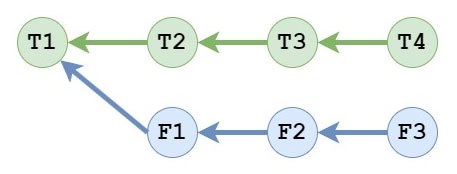It's time to understand the full power of Git's rebase capabilities while Allen takes a call from Doc Brown, Michael is breaking stuff all day long, and Joe must be punished.
The full show notes for this episode are available at https://www.codingblocks.net/episode193.
News
- Thanks for the review Itsamritchahal!
- Want to help out the show? Leave us a review!
- Ludum Dare is a bi-annual game jam that's been running for over 20 years now. Jam #51 is coming up September 30th to October 3rd. (ldjam.com)
- We previously talked about Ludum Dare in episode 146.
Branching and the power of rebase
- Every branch you work in typically has one or more base commits, i.e. the commits the branch started from.
git branchshows the branches in your local repo.git show-branchshows the branch ancestry in your local repo.- Reading the output from the bottom up takes you from oldest to newest history in the branches
- Plus signs, are used to indicate commits on divergent branches from the one that's currently checked out.
- An asterisk, is used to indicate commits that happened on the current branch.
- At the top of the output above the dashed line, the output shows the branches, the column and color that will identify their commits, and the label used when identifying their commits.
- Consider an example repo where we have two branches,
TandF, whereT= Trunk andF= Feature and the commit history looks like this:
- What we want to do is bring Feature up to date with what's in Trunk, so bring
T2,T3, andT4intoF3.- In most source control systems, your only option here is to merge, which you can also do in Git, and should be done if this is a published branch where we don't want to change history.
- After a merge, the commit tree would look like this:
- The
F3'commit is essentially a "meta-commit" because it's showing the work necessary to bringT4andF3together in the repository but contains no new changes from the working tree (assuming there were no merge conflicts to resolve, etc.)- If you would rather have your work in your Feature branch be directly based on the commits from Trunk rather than merge commits, you can do a
git rebase, but you should only do this for local development. - The resulting branch would look like this:
- If you would rather have your work in your Feature branch be directly based on the commits from Trunk rather than merge commits, you can do a
- You should only rebase local branches because you're potentially rewriting commits and you should not change public history.
- When doing the merge, the merge commit,
F3'is an instruction on how to transformF3 + T4.
- When doing the rebase, the commits are being rewritten, such that
F1'is based onT4as if that's how it was originally written by the author.
- When doing the merge, the merge commit,
- Use
rebasefor local branches that don't have other branches off it, otherwise usemergefor anything else.
Interactive rebasing
git rebasewill try to automatically do all the merging.git rebase -iwill allow you to handle every aspect of the rebase process.- pick – This is the default behavior when not using
-i. The commit should be applied to its rewrit
- pick – This is the default behavior when not using
Popular Podcasts
Las Culturistas with Matt Rogers and Bowen Yang
Ding dong! Join your culture consultants, Matt Rogers and Bowen Yang, on an unforgettable journey into the beating heart of CULTURE. Alongside sizzling special guests, they GET INTO the hottest pop-culture moments of the day and the formative cultural experiences that turned them into Culturistas. Produced by the Big Money Players Network and iHeartRadio.
Crime Junkie
Does hearing about a true crime case always leave you scouring the internet for the truth behind the story? Dive into your next mystery with Crime Junkie. Every Monday, join your host Ashley Flowers as she unravels all the details of infamous and underreported true crime cases with her best friend Brit Prawat. From cold cases to missing persons and heroes in our community who seek justice, Crime Junkie is your destination for theories and stories you won’t hear anywhere else. Whether you're a seasoned true crime enthusiast or new to the genre, you'll find yourself on the edge of your seat awaiting a new episode every Monday. If you can never get enough true crime... Congratulations, you’ve found your people. Follow to join a community of Crime Junkies! Crime Junkie is presented by Audiochuck Media Company.
The Brothers Ortiz
The Brothers Ortiz is the story of two brothers–both successful, but in very different ways. Gabe Ortiz becomes a third-highest ranking officer in all of Texas while his younger brother Larry climbs the ranks in Puro Tango Blast, a notorious Texas Prison gang. Gabe doesn’t know all the details of his brother’s nefarious dealings, and he’s made a point not to ask, to protect their relationship. But when Larry is murdered during a home invasion in a rented beach house, Gabe has no choice but to look into what happened that night. To solve Larry’s murder, Gabe, and the whole Ortiz family, must ask each other tough questions.


